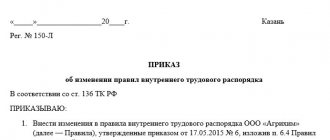The essence of the wage fund
The wage fund (WF) includes all expenses for remuneration of personnel, including bonuses, allowances, compensation from any sources of financing. Through this indicator:
- Conduct an analysis of wage costs for employees of different structural divisions (categories),
- They regulate and optimize costs, adjust rates, salaries, and prices.
The formula for calculating the wage fund makes it possible to calculate the amount of the fund, thanks to which all payments provided for by law (pension contributions, insurance contributions, etc.) are calculated.
https://youtu.be/giZ9ElyycYs
The wage fund is the most important tool for rationalizing the organization's expenses and motivating staff.
Payroll structure
The fund includes amounts to be paid to the employee in cash or in kind:
- Payroll fund (WF): accrued salary;
- the cost of products issued as wages;
- additional pay for days off on holidays, paid time off, bonuses for overtime and night work;
- regular bonuses in any form, including rewards for long continuous work experience;
- hazard pay;
- payment to non-registered employees, part-time employees, contracted persons, including fees for one-time services, consultations, etc.
- the period of performing public duties, agricultural work;
- the cost of company shares issued to employees, benefits for their purchase;
- travel expenses;
This does not include:
- annual one-time bonuses;
- payment of dividends to employees;
- any financial assistance;
- awards from special funds of the organization;
- loans provided to personnel, benefits, reimbursement of travel costs, vouchers, etc.
The wage fund includes four groups:
- direct salary for working hours;
- salary for hours not worked;
- premium part;
- accruals for accommodation and meals.
Read our article about what wages are.
This includes various accruals, which include payment for unworked time. This also includes accruals for annual paid leave, as well as preferential hours for minors.
The bonus part is a one-time payment that is received as a reward for the results of labor worked for many years at the enterprise, etc.
This is the price of food and housing, which, taking into account the legislation, is due to workers in certain sectors of the economy, as well as compensation for expenses for these needs in excess of what was planned.
Direct salary consists in turn of the following indicators:
- Salary, which is accrued for work done at tariff rates, salaries and as a percentage of revenue.
- The price of a product that is issued as salary in kind.
- Incentive additional payments, which are made based on the accrual rules at a particular enterprise.
- Premium part. These payments can be either permanent or occur from time to time.
- Compensation for work schedule and circumstances that forced you to work, for example, at night.
- Salaries for qualified personnel who were invited to train the organization’s workers.
- Salary for labor of those employees who worked part-time.
The wage fund also includes those finances that are paid to workers for their work. This refers to those citizens who work in permanent and temporary jobs, as well as funds due to persons under the law of the Russian Federation for unworked time (women on maternity leave, etc.).
The payroll fund includes:
- Cost of services or products.
- Means that have a specific purpose.
- Admission and funding.
- Salary expenses are charges that are intended by the organization for individuals and are included in the initial cost of the goods.
The wage fund usually includes amounts that are payable to the employee in cash or in kind.
The wage fund consists of the following components:
- accrued salary;
- products issued as remuneration (its cost);
- additional payment for work on holidays or weekends;
- bonus for overtime and night work;
- regular bonuses of any form, including rewards for long continuous work experience;
- hazard pay;
- payment to employees who are not on the payroll;
- payment to persons hired part-time, drawn up under contracts, including fees for one-time and consulting services, etc.
The wage fund includes payment for unworked time, which includes the following items:
- payment for time spent performing public duties or agricultural work;
- payment for employee training time aimed at retraining or advanced training,
- payment for all types of leave, including maternity leave, except for unused leave, etc.
Incentive payments can include:
- the cost of shares issued to employees,
- gifts and incentives, etc.
Payroll fund: calculation formula
Bonus expenses can be calculated in the same way as salary expenses. But it is not a fact that the company will have such resources next year. It remains to add the two resulting amounts to get the payroll.
Let’s assume that the director spent 540,000 rubles on additional payments last year. On average, each employee received 15,000 rubles per month (540,000 / 3 / 12). For four people you will need 15,000 × 4 × 12 = 720,000 rubles per year.
Thus, payroll = 1,680,000,720,000 = 2,400,000 rubles.
https://youtu.be/poZPAiP12oo
For clarity, you can add separately annual plans for the following payments:
- bonuses (monthly and for special merits);
- allowances (for length of service, for intensity, for working conditions);
- material aid;
- vacation pay.
The result will not change, but the manager will be able to trace what the structure of the payroll consists of.
If a company decides to produce 500,000 units of goods in a year and pay workers 100 rubles for each release, then 50,000,000 rubles will be spent on wages.
Knowing what payroll (payroll fund) is, how to calculate this indicator, what components it consists of, you can conduct effective planning. This will prevent staff turnover and at the same time optimize costs.
To calculate the annual wage fund you need:
- payroll statements for the year, they reflect all amounts of accrued payments to employees.
- a time sheet, which is used to determine the number of hours worked (the timesheets are filled out every month by responsible persons, and the responsibility is indicated in the job description).
- The staffing table, which specifies tariff rates, salaries, and the list of employees of the company.
There is no required formula for calculating the annual payroll amount. The formula for calculating the wage fund can be calculated in two ways.
PHOT = Zsr*Chsr*12
Here payroll is the wage fund;
Zsr - average monthly salary;
Chsr - average number of employees.
The average salary is obtained by adding the sum of all accruals and payments that are part of the wage fund, divided by 12. The average number of employees is calculated by summing the number of employees for each day of the month and divided by calendar days.
When calculating the annual indicator, the actions are repeated for the period from January to December, all the resulting numbers are added and then divided by 12.
These calculations are made in various ways: based on the planned production volume or taking into account the salary of each employee of the enterprise. In the latter case, pay slips, the company's staffing table and time sheets for previous periods are used for calculations.
Payroll = (Salary ND)xRK, where
Payroll - salary fund; ZP - salary for the year; ND - allowances, additional payments; RK - established regional coefficient.
FOT=ZPx(OK ND RK), where
ZP - monthly salary, OK - monthly salary or tariff rate, ND - allowances, bonuses, RK - regional coefficient.
Difference from FZP
The wage fund is the amount distributed for work performed among employees in accordance with the tariff rates, salaries, and piece rates established by the enterprise.
It includes:
- remuneration in any form;
- additional payments, allowances, bonuses;
- compensation in connection with working conditions.
Social benefits do not include amounts of social payments.
The wage fund is a broader concept and includes the amount of absolutely all accruals to the organization’s employees, including the wages and salaries. Unlike payroll, the salary fund includes only the amount for time worked and bonuses directly related to it.
Carrying out analysis
This is also an important measure that allows us to identify the reasons why actual deviations in payroll indicators from planned ones occur. It is also important to compare the growth of labor productivity and the level of employee wages.
As a result of such an analysis, a set of measures should be formed aimed at changing the situation.
This operation is directly related to the previous paragraph. Making a plan and paying wages is not everything. It is necessary to analyze how much the planned diverged from the actual.
The company has drawn up a payroll plan. This is a specific figure that was planned to be spent on paying workers. There are rare cases when the actual amount spent and the planned amount agree, and any discrepancy must be analyzed.
If the discrepancy happened in favor of the company, then a smaller payroll can be planned for the next year, but if the planned funds were not enough, then you need to understand what contributed to this. Perhaps production rates have increased, more labor was needed, or a crisis has occurred.
If this was not predicted, then it is necessary to work with the planning department or accounting department so that everything is taken into account in the future.
In large companies, we may be talking about a discrepancy between the plan and actual payments of several millions, and the task of the financial department is to make sure that there is always a source for paying salaries, despite force majeure.
https://youtu.be/5HykqrRC7xc
Often, when analyzing, large manufacturers use not only their own data, but also data from competitors. All information necessary for this is open, so this analytics is legal and uncomplicated. And its advantage is that you can use the experience of other companies - both positive and negative.
Payroll calculation period
Depending on the reporting unit, there are the following payroll calculation periods:
- Annual. This period is most often used to determine the amount of the wage fund. Data for the most recent calendar year is used.
- Monthly. For reporting, the monthly payroll is no less important than the annual one.
- Day. This period is used much less frequently, usually for a more in-depth analysis of wage costs.
- Hourly. Used by organizations that choose the hourly wage method.
In accordance with the reporting unit, the following periods for calculating the wage fund can be distinguished:
- The annual fund, most often used in determining the amount of the wage fund. In these calculations, the formula for calculating the wage fund includes data for the last calendar year.
- Monthly fund, which is no less important for reporting than the annual payroll.
- Daily payroll, used less frequently, but necessary for a more thorough analysis of wage costs.
- The hourly fund is used in enterprises using the hourly wage method.
Payment procedure
First of all, you need to collect information regarding the structure of the enterprise, as well as the number of personnel. It is equally important to clarify the average salary and the indicators that you need to focus on, as well as the staffing table, planning conditions and other important data that in one way or another may relate to the size of the salary.
Next, you need to determine the time period for which the wage fund is calculated and calculate the average number of employees who will be employed at the enterprise during this period.
Knowing the above indicators, all that remains is to calculate the wage fund.
We suggest you familiarize yourself with Registering a car using a handwritten power of attorney
How to calculate the annual payroll?
To calculate it, you need to have:
- Salary statements for the year. These documents indicate all amounts of accrued payments to employees.
- Time sheets. They can be used to determine the number of hours worked. Filled out every month by the responsible person; this responsibility must be specified in the job description.
- Staffing schedule. It indicates tariff rates, salaries, as well as the list of employees of the organization.
There is no mandatory formula for calculating the annual amount, but the indicator can be calculated using two methods.
FOT = SZ*SCH*12, where
- Payroll - wage fund;
- SZ - average monthly salary;
- SCH - average number of employees.
The average salary can be obtained if the sum of all accruals and payments included in the payroll is divided by 12.
The average number of employees can be calculated by adding the number of employees for each day of the month and dividing by calendar days. For the annual indicator, you need to repeat the steps for the period from January to December, add all the resulting numbers and divide by 12.
Calculation example. Let’s say the average monthly salary is 354 thousand rubles, including allowances and additional payments. Let calculations show that the annual average number of employees is 10 people.
- Payroll = 354*10*12 = 42,480 thousand rubles.
Payroll = (salary ND)*RK, where
- ZP - salary for the year;
- ND - allowances, additional payments;
- RK is an established regional coefficient for organizations operating in the conditions of the Extreme Server and territories equivalent to it.
Calculation example. Let's say the company is located in the Magadan region. Salary for the year amounted to 20 million rubles, allowances - 4988.3 thousand rubles. The coefficient for the territory is 1.7.
- Payroll = (20,000 4988.3)*1.7 = 42,480 thousand rubles.
To learn how to calculate the average number of employees per year, read this article.
How payroll is calculated at an enterprise - see here.
Since this indicator is a planned one, the average salary value for the entire organization is used to determine it. And it is calculated from the actual indicators of the previous year.
Let's take for example a small company, which last year consisted of:
- directors with a salary of 60,000 rubles;
- manager with a salary of 30,000 rubles;
- security guard with a salary of 15,000 rubles.
During the year, (60,000 30,000 15,000) × 12 = 1,260,000 rubles were spent on payments.
The amount spent on remuneration for the labor of all employees is divided by their average number of employees (ASH) for that year and by 12 months.
Since we have three employees, we will receive an average salary for the company equal to 35,000 rubles.
The average headcount should be taken at the current moment. And if the director hires another employee, the salary for the next year will be: 35,000 × 4 × 12 = 1,680,000 rubles.
But labor costs can be planned not only for a year, but also for shorter periods. Then, instead of the MSS, the number of man-hours spent should be used.
https://youtu.be/87aPElkW2FA
Planning
No financial decisions in a company are made just like that, especially when millions are involved; each organization draws up a plan on the basis of which all payments to employees will be made.
Any enterprise has an “untouchable” amount of its funds, which is designed to pay wages. The size of the payroll is determined for the year; for this, the number of employees is multiplied by the average monthly salary and multiplied by 12 months. The resulting figure determines how much money will be needed for payments.
We invite you to read: What is the amount of alimony for parents of pensioners?
Any enterprise is also designed for growth, for the fact that the volume of its productivity will increase, and if this happens, then the number of employees will increase, and therefore the amount of the salary will increase. Therefore, planning also includes forecasting growth rates, as well as assessing possible associated costs.
The most productive planning method is extrapolation. This is planning, which is carried out in several stages:
- The size of the payroll for the past year is analyzed;
- Calculations are being made on how to reduce this figure, if possible;
- An analysis of external factors that may affect the size of the fund is carried out;
- The plan is submitted to management, who approves or finalizes it.
Of course, in ideal conditions the planning department should do this, but if it does not exist, then the financial department or accounting department can carry out the calculations.
It should be noted that for any business payroll is an expense item. That is why it is important to pay enough attention to its planning. The wage fund includes contributions for social needs, as well as for the payment of salaries and bonuses. You should not strive to excessively reduce your payroll. Because the absence of bonuses and other payments will lead to low motivation of employees and, as a result, poor performance of duties. Ultimately, this reduces the profit of the enterprise, as well as its competitiveness.
The wage fund must correspond to the interests of not only managers, but also employees. By performing his duties efficiently, a qualified specialist wants to receive a decent remuneration for his own work, as well as have social guarantees in the form of sick leave, vacation benefits, etc.
If there is a shortage of funds, it is recommended to plan the financial policy of the enterprise in such a way as to first fulfill obligations to employees and only then calculate profits. However, the reality is that many managers primarily care about their own income, allowing themselves to delay the payment of wages to employees.
Payroll planning allows you to know exactly its size and, based on this information, regulate personnel policy. For example, due to a shortage of funds for wages, it is necessary to reduce the number of employees or find other ways to reduce the costs of the enterprise








